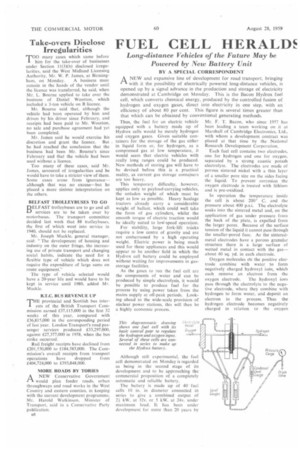FUEL CELL HERALDS " ELECTRIC "
Page 42

Page 43

If you've noticed an error in this article please click here to report it so we can fix it.
Long-distance Vehicles of the Future May be Powered by New Battery Unit
BY A SPECIAL CORRESPONDENT
A NEW and expansive line of development for road transport, bringing I-1 with it the possibility of electrically powered long-distance vehicles, is opened up by a signal advance in the production and storage of electricity demonstrated at Cambridge on Monday. This is the Bacon Hydrox fuel cell, which converts chemical energy, produced by the controlled fusion of hydrogen and oxygen gases, direct into electricity in one step, with an efficiency of about SO per cent. This figure is several times greater than that which can be obtained by conventional generating methods.
Thus, the fuel for an electric vehicle equipped with a battery made up of Hydrox cells would be merely hydrogen and oxygen gases. Given suitable containers for the storage of the gas either in liquid form or, for hydrogen, as a compressed gas at low temperature, it would seem that electric vehicles with really long ranges could be produced. New methods of storing gas will have to be devised before this is a practical reality, as current gas storage containers are too heavy.
This temporary difficulty, however, applies only to payload-carrying vehicles, the unladen weight of which must be kept as low as possible. Heavy haulage tractors already carry a considerable weight of ballast, which could well take the form of gas cylinders, whilst the smooth torque of electric traction would be ideally suited to loW-speed operation.
For stability, large fork-lift tricks require a low centre of gravity and are not embarrassed by a high operating weight. Electric power is being much used for these appliances and this would appear to be another field in which the Hydrox cell battery could be employed without waiting for improvements in gasstorage facilities.
As the gases to run the fuel cell are the components of water and can be produced by simple electrolysis, it would be possible to produce fuel for the process by using power taken from the mains supply at off-peak periods. Looking ahead to the wide-scale provision of nuclear power stations, this will then be a highly economic process.
Although still experimental, the fuel cell demonstrated on Monday is regarded as being in the second stage of its development and to he approaching the commercial proposition of a completely automatic and reliable battery.
The battery is made up of 40fuel cells 10 in. in diameter connected in series to give a combined output of 21 kW. at 32v. or 5 kW. at 24v. under maximum load. It has been under development for more than 20 years by
Mr. F. T. Bacon, who since 1957 has been leading a team working on it at Marshall of Cambridge Electronics, Ltd., with whom a development contract was placed at that time by the National Research Development Corporation.
Each fuel cell contains two electrodes, one for hydrogen and one for oxygen. separated by a strong caustic potash electrolyte. The electrodes are made of porous sintered nickel with a thin layer of a smaller pore size on the sides facing the liquid. To prevent corrosion the oxygen electrode is treated with lithium and is pro-oxidized.
In operation the temperature inside the cell is about 200" C. and the pressure about 400 p.s.i. The electrolyte soaks into the sintered metal and, on the application of gas under pressure from the back of the plate, is expelled from the larger pores. Because of the surface tension of the liquid it cannot pass through the smaller-pored face. As the sinteredmetal electrodes have a porous granular structure there is a large surface of wetted metal in contact with the gas— about 40 sq. yd. in each electrode.
Oxygen molecules dri the positive electrode combine with water to form negatively charged hydroxyl ions, which each remove an electron from the
oxygen electrode. The hydroxyl ions pass through the electrolyte to the negative electrode, where they combine with hydrogen to form water, and deposit an electron in the process. Thus the hydrogen electrode becomes negatively charged in relation to the oxygen
de and a current flows in the 11 circuit.
remove the water formed. hydrocirculated past the back of the te electrode and the mixture of :en and steam thus produced is externally, the condensate being d as required.
sure of the two gases must be balanced if damage is to be d. The control system which has roduced keeps the oxygen pressure at and controls the hydrogen .e against it by an accurate meter ng a power-operated inlet valve lied by a servo.
the necessary provision of highly te and expensive control gear makes it doubtful whether the 11 battery could ever be competiith existing types of accumulator tputs of less than 100 W. Never, the advantages already described, :hers, such as the ability to take )verloads without damage, silence tedom from vibration in operation. , moving parts and an " exhaust ing only of water, make the fuelutery an obvious proposition for ng road vehicles.
fuel cell battery was shown powerRansomes fork-lift truck, a small nch and an electric welding plant wander-lead. Although the size present control gear makes vehicle ttions impracticable, it is foreseen , this equipment is perfected it will ,de smaller and then a 10-kW. complete with control gear could ised within a 30-in, cube.
lossibility for commercial vehicle itions is that tubular frame memhese may be more widely used as chassis frames become required igh-speed motorway operation) be employed either as containers bottles or as pressure vessels in Ives.
D. Hennessey, deputy managing r of the N,R,D.C., predicted that present rate of progress it would wilier five to seven years to make ;I-cell battery a practical commeroposition,




















































































































